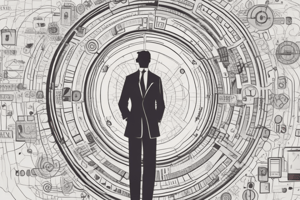Podcast
Questions and Answers
What is the primary function of organizational culture within a company?
What is the primary function of organizational culture within a company?
- It serves as a powerful template for guiding employee behavior. (correct)
- It creates external partnerships with other organizations.
- It dictates the company's profit-sharing strategy.
- It establishes formal hierarchies among employees.
Which of the following best reflects the importance of organizational subcultures?
Which of the following best reflects the importance of organizational subcultures?
- They can reinforce the main organizational culture and enhance overall cohesion. (correct)
- They create conflict and confusion across different departments.
- They replace the main organizational culture completely.
- They have no significant impact on organizational outcomes.
What elements are critical for merging organizational cultures successfully?
What elements are critical for merging organizational cultures successfully?
- Identifying and aligning shared values and practices from both cultures. (correct)
- Maintaining the original structures of both organizations without change.
- Understanding individual employee preferences and integrating them into one culture.
- Completely eliminating all elements of the existing cultures.
Which statement accurately describes the values and assumptions inherent in an organization?
Which statement accurately describes the values and assumptions inherent in an organization?
Why is organizational culture often referred to as a company's DNA?
Why is organizational culture often referred to as a company's DNA?
Flashcards
Organizational Culture
Organizational Culture
The shared values, beliefs, and assumptions that guide the behavior of individuals within an organization. It is considered the "DNA" of the company, shaping how employees think and act.
Organizational Subcultures
Organizational Subcultures
Distinct cultures that emerge within a larger organization. These subcultures can reflect different departments, teams, or even geographical locations.
Artifacts of Organizational Culture
Artifacts of Organizational Culture
The visible and tangible aspects of an organization's culture, such as physical layout, dress code, or even the language used in communication.
Organizational Culture Profile
Organizational Culture Profile
Signup and view all the flashcards
Merging Organizational Cultures
Merging Organizational Cultures
Signup and view all the flashcards
Study Notes
Organizational Culture
- Organizational culture is defined as the shared values and assumptions within an organization.
- It provides direction for "right way" of doing things.
- A company's DNA, it is invisible yet shapes employee behavior.
Learning Objectives
- Describe aspects of organizational culture, and the significance of subcultures.
- Compare and contrast strategies for merging organizational cultures.
- Detail five strategies to alter and strengthen an organization's culture, and how attraction-selection-attrition theory relates.
- Detail the organizational socialization process and how to improve it.
Organizational Culture Defined
- The values and assumptions within an organization are shared.
- This provides direction towards the correct method of conducting business.
- A company's "DNA" functions as a powerful, but invisible, template for employee behaviour.
Elements of Organizational Culture
- Artifacts: Physical structures, language, rituals, ceremonies, stories, legends.
- Represents observed aspects and visible symbols of culture.
- Shared Values: Conscious beliefs, evaluating what's good and bad, right and wrong.
- Are the publicly-stated principles, values.
- Shared Assumptions: Nonconscious beliefs; taken-for-granted concepts, implicit mental models, prototypes of behaviour.
- These are deeply ingrained, unstated norms in a culture.
Organizational Culture Profile
- Dimensions: Innovation, stability, respect for people, outcome orientation, attention to detail, team orientation, aggressiveness.
- Each dimension is related to specific characteristics and behaviours within the culture.
Organizational Subcultures
- Dominant Culture: Values/assumptions most commonly shared.
- Subcultures: Exist throughout the organization; distinct from the dominant culture.
- Countercultures: Subcultures that oppose elements of the dominant culture.
- Plays a key role as a source of feedback and new values.
Organizational Culture Artifacts
- Observable symbols and signs of culture, such as physical structures, ceremonies, language, and stories.
- Contribute to maintaining and transmitting the organization's culture.
Artifacts: Stories and Legends
- Provide social prescriptions for desired (or dysfunctional) behavior.
- Legends/stories portray the human side of the organization, fostering expectations and understanding of how to operate within it.
- Effective stories/legends depict real people, are widely accepted as truth within the organization, and function as a guide for behaviour.
Artifacts: Language, Rituals, Ceremonies
- Language: How employees communicate and address each other, expressing emotions, and describing stakeholders.
- Rituals: Repetitive routines, showing organizational values and procedures, e.g., how visitors are greeted.
- Ceremonies: Planned, public activities, often with an audience, e.g., award ceremonies, emphasizing culture and values.
Artifacts: Physical Structures/Symbols
- Building structures, office layouts, furniture, wall hangings, convey meaning that relates to culture and values.
Organizational Culture Strength
- The extent to which employees share and uphold the organization's values and assumptions.
- Characterized by employees understanding and embracing the culture, institutionalized through artifacts, with lasting impact, possibly from founders of the organization.
Organizational Culture and Effectiveness
- Culture strength impacts organizational outcomes (performance, employee well-being).
- The fit with the environment is essential, a strong culture that doesn't appropriately reflect their environment will not be successful.
Contingencies of Culture Strength
- Culture content alignment with the environment is crucial.
- Misaligned culture leads to wrong decisions and poor behaviours in relationships with stakeholders.
- Culture strength should not be cult-like, preventing dissenting values and suppressing subcultures.
- Adaptive capabilities and continuous change are essential for success in a dynamic environment.
Merging Cultures: Bicultural Audit
- Part of the due diligence in mergers; identifying companies' cultures.
- Steps:
- Identifying cultural artifacts
- Analyzing data for culture conflict or compatibility
- Developing strategies and action plans to bridge cultures
Merging Organizational Cultures
- Assimilation: Acquired firm adopts acquiring firm's culture.
- Deculturation: Acquiring firm's culture is imposed on acquired firm.
- Integration: Composite culture containing elements from both organizations.
- Separation: Each organization maintains its original culture.
How to Change/Strengthen Organizational Culture
- Strategies for changing or strengthening organizational culture.
Changing/Strengthening Organizational Culture
- Use attraction, selection and socialization to ensure cultural "fit"
- Model desired culture from founders and leaders.
- Support workforce stability and communications.
- Align artifacts to desired outcome.
- Introduce culturally consistent rewards/recognition
Attraction-Selection-Attrition Theory
- Culture strength is increased via:
- Attraction: Applicants choose companies commensurate with their values.
- Selection: Companies choose applicants based on compatibility with organizational values.
- Attrition: Employees with differing values leave, strengthening cultural coherence
Organizational Socialization
- The process by which individuals learn the values, behaviours, and knowledge expected in an organization.
Learning Process (in Organizational Socialization)
- Newcomers develop organizational comprehension.
- Newcomers learn expectations, power dynamics, culture, and jargon.
- Social relationships are formed.
Adjustment Process (in Organizational Socialization)
- Newcomers adapt to the new work environment.
- Newcomers develop new work roles and social identities.
- Newcomers adopt team norms.
Stages of Organizational Socialization
- Pre-employment socialization: Learning about the organization and role.
- Encounter: Testing pre-conceived thoughts about the organization against realities.
- Role Management: Strengthening work relationships, new role behaviours, work-nonwork conflicts resolved.
Improving Organizational Socialization
- Realistic job previews (RJPs): Balanced view of job and its context.
- Socialization agents: Supervisors and co-workers who provide information, feedback, and support.
Edgar Schein
- Known for his work on organizational culture and leadership.
Studying That Suits You
Use AI to generate personalized quizzes and flashcards to suit your learning preferences.




